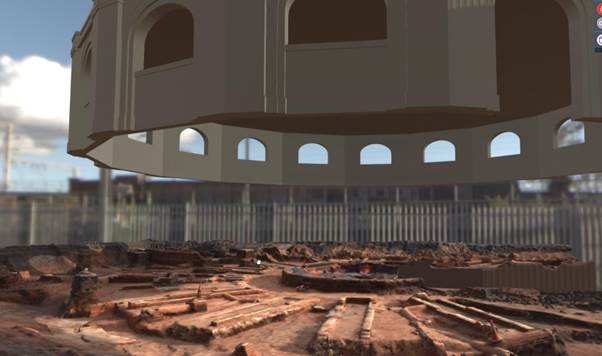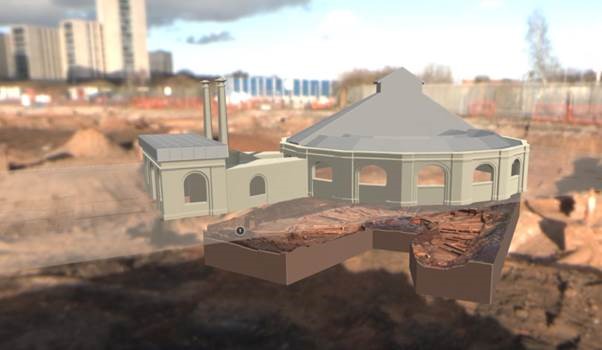Jon Millward, Historic Environment Manager, HS2
As part of the enabling works for the construction of HS2 an extensive programme of archaeological excavation has been undertaken. This work has led to the discovery of extensive remains relating to the former Curzon Street railway station, Birmingham, which opened in 1838. Part of this complex was the earliest identified roundhouse in the world.
The excitement garnered by the discoveries meant that HS2 working with their supply chain (Laing Murphy JV (LM); Design JV – a partnership of WSP and Ramboll (DJV); MOLA Headland Infrastructure (MHI); and Wessex Archaeology) developed a plan to ensure public accessibility to the site for several months whilst also delivering a programme of media events to provide widespread exposure of the findings.
The initial discoveries were publicly announced through a press release, television and newspaper interviews and a site visit by journalists and vloggers (YouTube: Hidden Railway Find of HS2 | Birmingham Curzon Street | Railway Vlogger and YouTube: Historic railway roundhouse discovered at Curzon Street station). This led to a high level of exposure for the site and fuelled public interest in the archaeology.
The implementation of Covid-19 restrictions suddenly meant that the planned, site-based, events were no longer deliverable and digital means of communication were thereafter to provide the focus of our collaborative public engagement.
The team at DJV realised that much of the data already collected for the recording of the site could be repurposed for public engagement purposes, drone footage captured by the remediation company working on the site (McAuliffe) was re-edited to focus on the key areas of archaeological interest so that it could be released via HS2 social media channels Twitter and YouTube: (Curzon Street Roundhouse Drone Footage April 2020). In the background DJV had contacted the Visualising Heritage team at the University of Bradford to provide specialist digital deliverables including photogrammetry, structure from motion 3D modelling and 3D reconstruction of the elements of the roundhouse that had been demolished in 1860. The models have been used in outreach events and it is accepted that they provide a detailed record of the asset as well as being engaging and informative. An Historic England Inspector involved with the project noted that the reconstructions had completely changed their understanding of the design and evolution of the roundhouse.
Webinars were designed, and a number have been delivered, with c. 600 members of the public having attended live events so far. The digital platform has allowed community engagement to continue despite site visits not being possible at the present time. Collaborative working has ensured that the right mixture of detail and visualisations have been combined to deliver engaging and effective engagement sessions. One of the events was run with rail heritage specialists as guest speakers (Anthony Coulls from the National Railway Museum and David Gwyn a rail historian) which allowed the Curzon Street site to be considered in the context of the Victorian railway mania. The webinars and other digital deliverables are all available online and will remain publicly available on the HS2 YouTube channel (The Archaeology of Hs2: Uncovering the Curzon Street roundhouse) and will also soon be available from Wessex Archaeology.
The necessary adaptation of the outreach programme as a result of the Covid-19 restrictions has been successful in creating highly effective and accessible engagement events and has driven forward a digital agenda rather than the traditional site visit approach that was initially considered. A key lesson learnt is that the use of a wide range of specialists in combination with digital media can be far more effective than traditional engagement methodologies in providing inclusive and entertaining deliverables. It is also key to note that the availability of recorded events online has proven to be an excellent opportunity for a wider audience to access the information on offer (one event had 185 people attend live; a further 1300 people have viewed it on YouTube subsequently.)



All images © Visualising Heritage/University of Bradford
Bringing together senior members of staff from public and non-government bodies to work collaboratively on strategic matters for the historic environment sector.